Last updated: April 14, 2023
Article
Volcanic Processes—Lahars
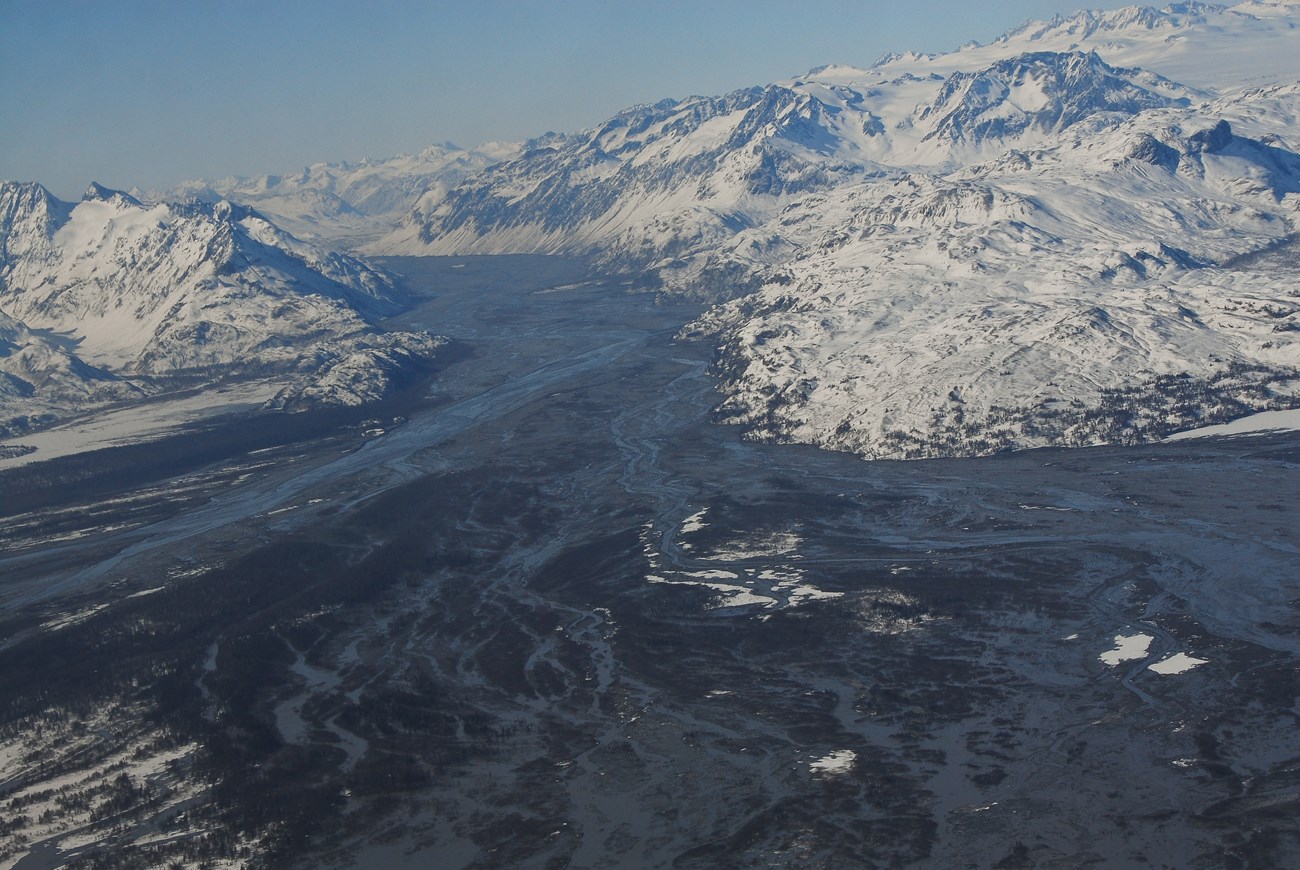
USGS photo.
Introduction
Lahars (volcanic mudflows) are among the most destructive of volcanic phenomena. They are important processes on composite volcanoes, like those in the Cascade Range in the Pacific Northwest and Aleutian volcanic arc in Alaska.
Lahars are mixtures of water, volcanic ash, tephra, rock fragments, and chunks of ice that can flow like wet concrete. The term comes from the Indonesian word for these destructive mudflows that cause both property damage and loss of life. They can occur with little to no warning.
Lahars mostly travel down river valleys and can reach great speeds, traveling up to 45-50 miles per hour (75-80 km per hour) or more on steep slopes. The concentration of volcanic debris in a lahar is variable; some lahars are relatively dilute and others are a thick slurry that can transport large boulders.
Lahars present significant geohazards since they can travel great distances down river valleys and impact population centers away from the immediate area of a volcano.


Left image
Redoubt Volcano in Lake Clark National Park following the April 4, 2019 eruption.
Credit: USGS photo.
Right image
Image with feature labels.
Credit: USGS photo.
There are two main types of lahars: hot and cold. Volcanologists in the Cascades use the term “debris flows” for smaller volcanic mudflows that do not occur in conjunction with eruptions and do not threaten large areas downstream.
Hot Lahars
Hot lahars are transported and emplaced having an elevated temperature. They are initiated during volcanic eruptions by several possible mechanisms:
-
Melting of snow or ice by ash and tephra ash fall, pyroclastic surges, pyroclastic flows, lava flows or domes, or other eruption phenomena melt snow or ice;
-
Liquification of very wet volcanic landslides;
-
Eruptions into crater lakes;
-
Heavy precipitation during eruptions.
Snow- and ice-covered volcanoes are particularly susceptible to lahars because melting particularly during eruptions can provide a great deal of water.
Hot lahars are also called primary lahars.
Cold Lahars
Cold lahars are not associated with eruptions and do not have an elevated temperature. They are usually initiated by heavy precipitation or snow melt events that mobilize loose volcanic deposits. Landslides, flooding, and glacial outburst flooding may also initiate lahars. These lahars frequently are smaller than the hot lahars that form during eruptions.
Cold lahars are also called secondary lahars and may occur long after eruptions.
Debris Flows
Debris flows do not originate with volcanic eruptions, but like lahars, they are mudflows that can transport rock debris. At Mount Rainier National Park and other volcanoes in the Cascade Range, the term is reserved for small events caused by slope failure, rainfall, snow or ice melt, or glacial-outburst flood.
Debris flows occur more frequently than large lahars.
Mount Rainier National Park
Lahars present the greatest geohazard from Mount Rainier, and the most significant geohazard from a volcano in the Cascade Range. Several large prehistoric lahars from Mount Rainier have traveled downstream all the way to the Tahoma area near Puget Sound.
The presence of ice and abundant surface water, along with the prevalence of hydrothermally-altered rock on the volcano’s slopes, have made Mount Rainier especially susceptible to lahars. Hydrothermal alteration weakens volcanic slopes since it produces abundant clay minerals.
The Osceola Mudflow was the largest lahar that occurred at Mount Rainier during the last 10,000 years. A large segment of the northeast side of the summit where it had been weakened by hydrothermal alteration collapsed during an eruption 5,600 years ago. The subsequent lahar traveled down the White River to Puget Sound. Deposits from the Osceola lahar cover an area about 212 square miles (550 square kilometers).
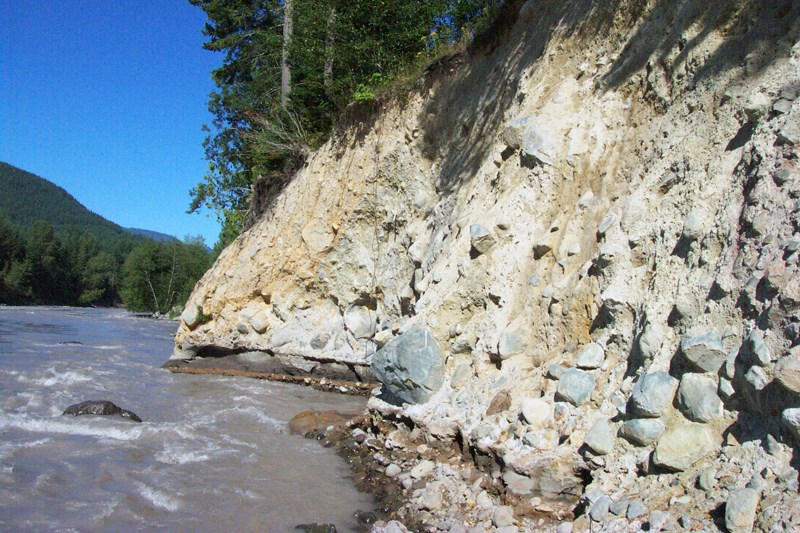
USGS photo.
Lassen Volcanic National Park
The May 19, 1915 eruption of Lassen Peak generated a lahar when a large explosion shattered the growing lava dome, sending blocks of hot lava onto the snow-covered slopes. This event triggered an avalanche of rock and snow that turned into a lahar when the snow melted. The lahar then flowed 7 miles (11 km) down Lost Creek. A larger lahar occurred on May 22 was triggered by snow melt caused by a pyroclastic flow. This lahar followed the same path as the previous lahar, but traveled further downstream in Lost Creek. Both lahars caused flooding downstream by the release of muddy water from the mudflow.
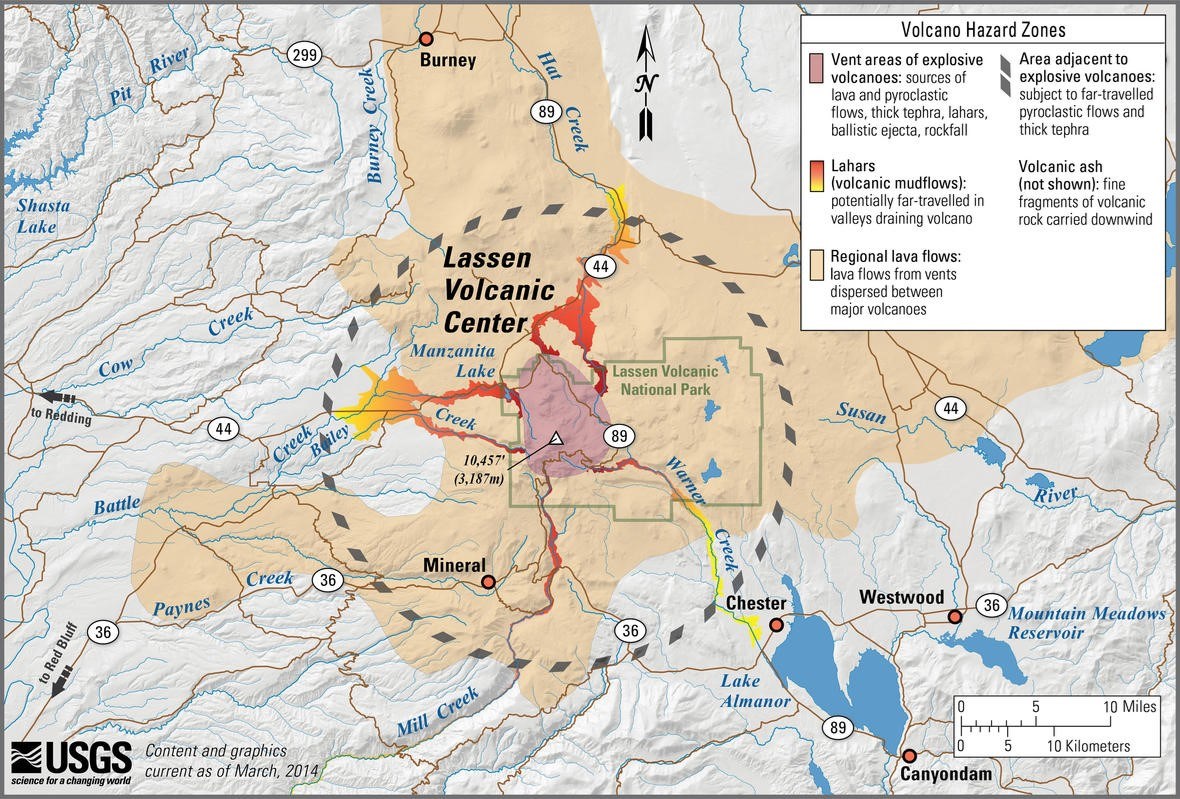
USGS image.
Redoubt Volcano, Lake Clark National Park
The 1989-1990 and 2009 eruptions of Redoubt both generated lahars. In 1990, lahars were generated when dome collapse in the crater produced significant meltwater. Pyroclastic flows that melted glacial ice also initiated lahars. The largest of these hot lahars inundated the Drift River valley all the way to the coast.
The 2009 eruption also produced hot lahars that left deposits wall-to-wall on the Drift River valley floor at depths of up to 16 ft (5 m). The lahars transported blocks of snow and ice as well as rock fragments.
Previous eruptions of Redoubt have also sent lahars down the Driver River valley.

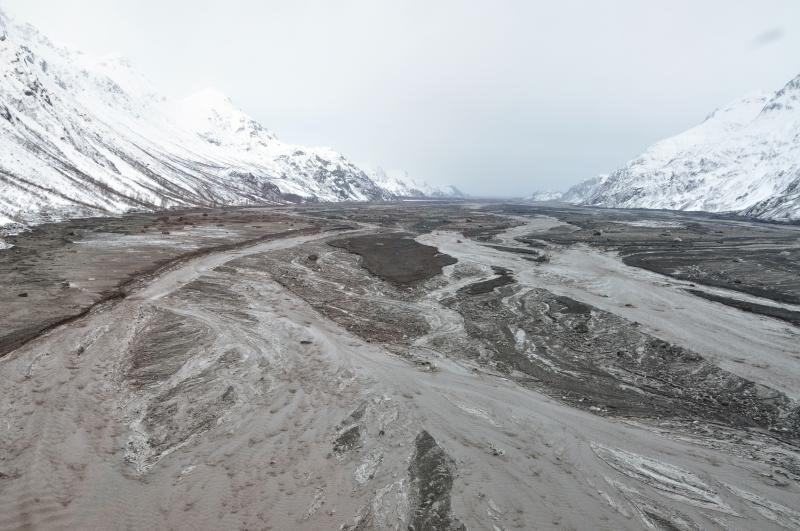
USGS photos.
Petrified Wood Fossils in Lahar Deposits
Trees and downed logs may become buried by lahar deposits. The preponderance of volcanic ash in lahar deposits and the presence of warm groundwater facilitate the replacement of wood by silica.
Yellowstone National Park and Florissant Fossil Beds National Monument both contain fossil wood in lahar deposits.
Yellowstone
Specimen Ridge, east of Tower Junction in Yellowstone National Park, is the site of the world’s largest concentration of petrified wood. These fossils trees are present in lahar deposits from the 50-million-year-old (Eocene) Absaroka Volcanic Field.
Fossils are of a great variety of trees, including spruce, ash, oak, and others, with sequoia trees being among the most common, are found in lahar deposits. Trees are found both upright and lying on the ground. Some of the upright trees were buried and became fossilized where they grew, but others were transported and deposited upright.
Featured Video
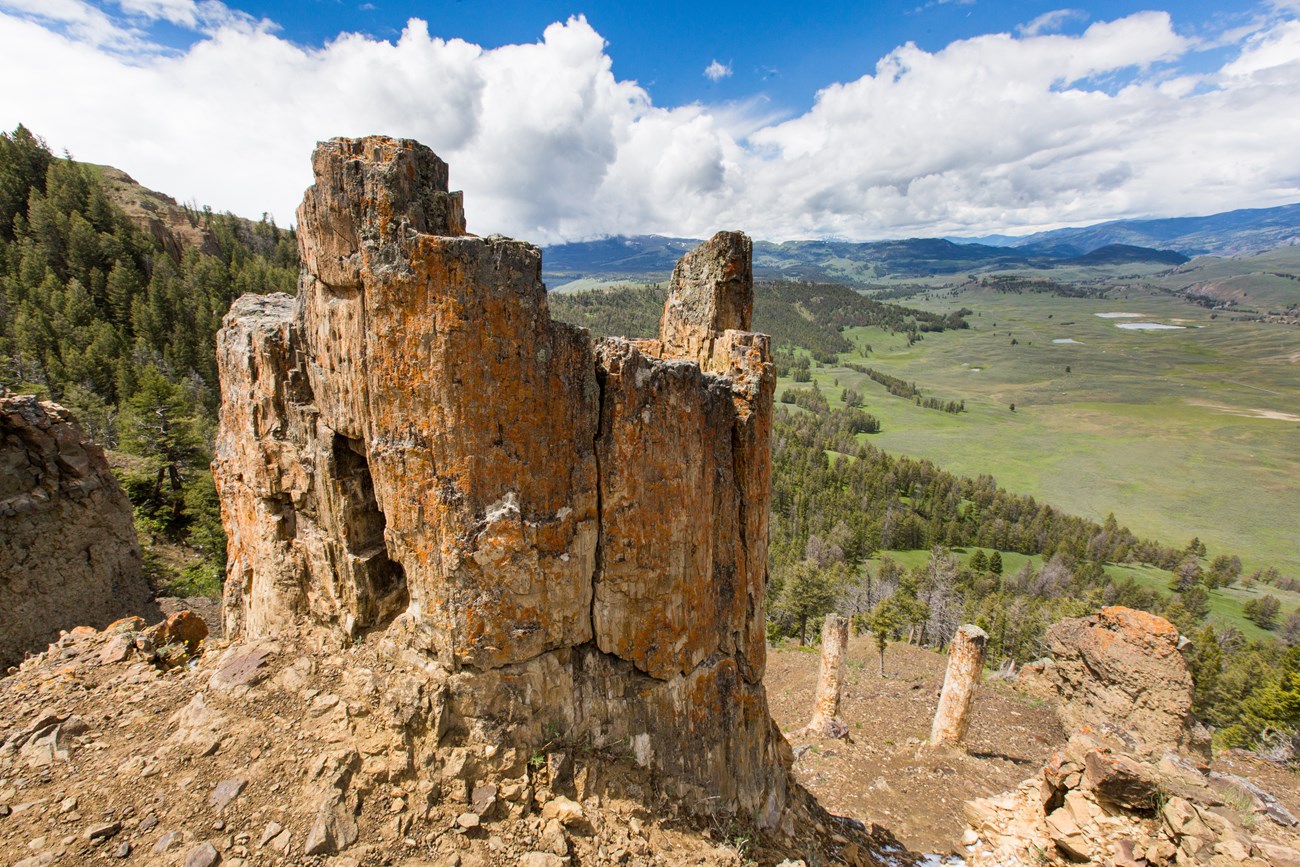
NPS photo by Neal Herbert.
Florissant Fossil Beds
The fossil tree stumps in Florissant Fossil Beds are about 34 million years old (Eocene), and were also preserved by lahar deposits. Thirty-one fossil stumps have been documented in the monument, and most are in a vertical orientation. Big Stump, one of the largest of these trees, is 12 feet (3.7 m) tall and has a diameter of nearly 11 feet (3.3 m). It is estimated that this redwood tree was about 750 years old and 230 feet (70 m) tall when it became buried by the lahar.
Featured Video
Transcript
We will start our tour by walking through the front doors of the visitor center, you see here, and right out on to the back patio.
Here we are on the back patio of the visitor center looking north at the Florissant valley.
Let’s continue down this sidewalk towards those large green metal roof shelters to see the stumps.
We’ve arrived at the first shelter and are looking at a petrified tree stump of a redwood tree. Let’s walk around this shelter towards that bench you see and take another look. Here’s another view of the same stump looking north at the Florissant valley.
Florissant Fossil Beds National Monument protects some of the largest petrified tree stumps in the world (by diameter) like the 13.5 foot-wide one pictured here.
Often, upon viewing these massive petrified redwood trees, many visitors ask “Redwoods in Colorado?”
As it turns out, redwood trees once lived across most of the Northern Hemisphere but you would have to travel back millions to tens of millions of years to see that.
This map of the world depicts the range of redwood trees during the geologic past with a green band extending from the western edge of North America, across the Northern Hemisphere to Greenland, Europe, and Asia.
Another question people ask when they see these stumps of stone is, how did they turn into solid rock?
To answer that question, let’s take a look at some artwork that reconstructs the ancient environment and geologic events that occurred here when these trees were growing 34 million years ago during a time known as the Eocene.
This artwork shows what the area may have looked 34 million years ago. Here we see a stream winding through a hardwood forest, with towering redwood trees,
and interesting animals like the Brontothere – a massive, 8 – 10 foot tall, two horned mammal. Near the Brontothere are miniature horses called Mesohippus.
About 18 miles to the southwest of the ancient stream valley there once existed a volcanic complex, an area of multiple related volcanic vents
as depicted in the background of this artwork.
At one point, a large amount of volcanic ash from an eruption mixed with rainwater and/or snow melt to create a giant lahar, or volcanic mudflow, that buried the area.
This artwork shows the massive, 15-20 foot tall, gray-colored lahar, moving through the ancient stream valley.
The trees were left buried in mud 15 feet thick. The lahar eventually turned to stone. The top parts of the trees died and decayed.
The stumps of the trees remained buried and decayed slowly which provided an opportunity for the process of fossilization to occur.
This artwork shows the magnified cross section of a buried petrified stump down to the cellular level.
The blue arrows represent ground water that penetrated the buried redwood stumps.
The ground water in that area was rich in the mineral silica from dissolved volcanic rock.
Over time, the minerals in the water were deposited in the cell spaces within the tree petrifying it
through a process called permineralization.
Let’s turn right now and head on over to the second shelter.
Here we are looking down at some unique fossils under the second shelter.
This is the world’s only known petrified trio of redwood stumps.
Here’s another view of the petrified trio.
You might notice that these three stumps are actually all connected…
and they are. As it turns out redwood trees can reproduce though a process
called stump sprouting. A redwood tree can create cloned sprouts out of its own root system.
And just on the other side of the trio we see this large stump
which is about 12 feet wide and over 10 feet tall.
You may have noticed that many of the stumps have metal banding around them.
The banding is part of an effort to help conserve and stabilize the trees which are still prone to deterioration through processes like freezing and thawing.
It is believed that these trees were excavated using dynamite in the early 20th century when the area was privately owned.
The excavation of the trees using dynamite caused large horizontal cracking.
When the area was privately owned, guests were allowed to collect and buy petrified wood…and in one case a whole stump!
Here is a stump that USED TO BE located near the trio and is now located in Disneyland Park in Anaheim California!
As mentioned before, previous to being a National Park unit, this area was a privately owned tourist site that sold fossil wood for souvenirs.
First, it was known as the New Petrified Forest and later the Henderson Petrified Forest and finally the Pike Petrified Forest.
In 1956, 12 year old tour guide Toby Wells encountered a visitor, who asked to buy a whole stump! It turned out to be Walt Disney who ultimately transported to Disneyland Park.
Since, 1969, these fossil stumps and all other natural and cultural resources within the Monument have been and continue to be protected by the National Park Service.
And finally, a bonus stump! This stump is not actually under the two metal roof shelters
it’s located nearby on the ½ mile Ponderosa Loop Trail and this stump is unique
as it exhibits a modern pine tree growing out of a 34 million year old petrified redwood.
Well, we’ve reached the end of the tour, we hope you enjoyed it.
- Duration:
- 7 minutes, 34 seconds
Join us for a virtual tour of some of the biggest petrified tree stumps on the Earth (by diameter). This virtual tour takes you behind the visitor center at Florissant Fossil Beds to an outdoor exhibit area.
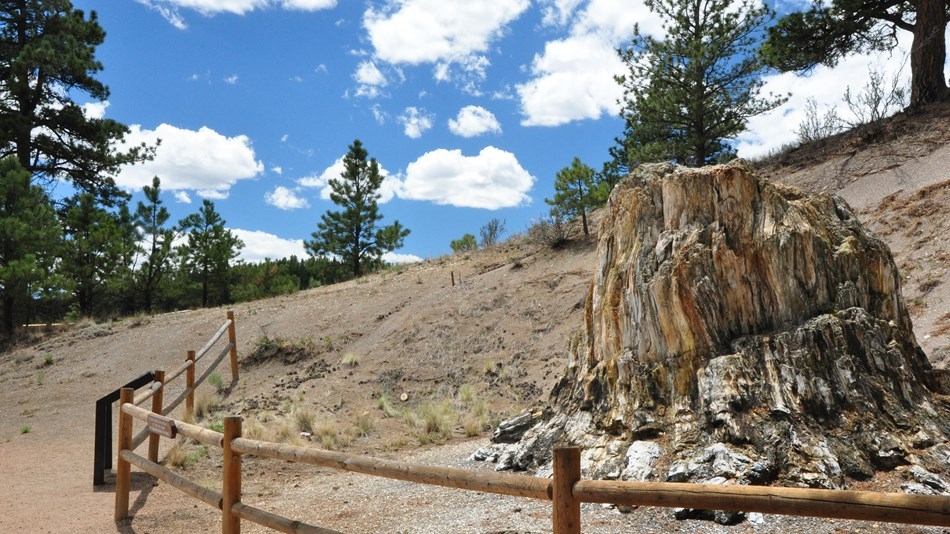
National Park Units with Lahar Deposits
-
Aniakchak National Monument (ANIA), Alaska—[ANIA Geodiversity Atlas] [ANIA Park Home] [ANIA npshistory.com]
-
Big Bend National Park (BIBE), Texas—[BIBE Geodiversity Atlas] [BIBE Park Home] [BIBE npshistory.com]
-
Crater Lake National Park (CRLA), Oregon—[CRLA Geodiversity Atlas] [CRLA Park Home] [CRLA npshistory.com]
-
Florissant Fossil Beds National Monument (FLFO), Colorado—[FLFO Geodiversity Atlas] [FLFO Park Home] [FLFO npshistory.com]
-
John Day Fossil Beds National Monument (JODA), Oregon—[JODA Geodiversity Atlas] [JODA Park Home] [JODA npshistory.com]
-
Katmai National Park (KATM), Alaska—[KATM Geodiversity Atlas] [KATM Park Home] [KATM npshistory.com]
-
Lake Clark National Park and Preserve (LACL), Alaska—[LACL Geodiversity Atlas] [LACL Park Home] [LACL npshistory.com]
-
Lassen Volcanic National Park (LAVO), California—[LAVO Geodiversity Atlas] [LAVO Park Home] [LAVO npshistory.com]
-
Mount Rainier National Park (MORA), Washington—[MORA Geodiversity Atlas] [MORA Park Home] [MORA npshistory.com]
-
Pinnacles National Park (PINN), California—[PINN Geodiversity Atlas] [PINN Park Home] [PINN npshistory.com]
-
Yellowstone National Park (YELL), Wyoming, Idaho, and Montana—[YELL Geodiversity Atlas] [YELL Park Home] [YELL npshistory.com]
Related Links
-
Florissant Fossil Beds—Stumps of Stone
Tags
- aniakchak national monument & preserve
- big bend national park
- crater lake national park
- florissant fossil beds national monument
- john day fossil beds national monument
- katmai national park & preserve
- lake clark national park & preserve
- lassen volcanic national park
- mount rainier national park
- pinnacles national park
- yellowstone national park
- volcanoes
- lahar
- volcanic processes
- geology
- geohazards
